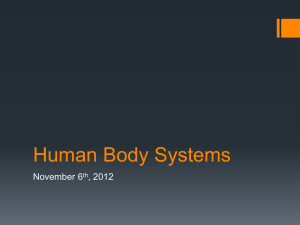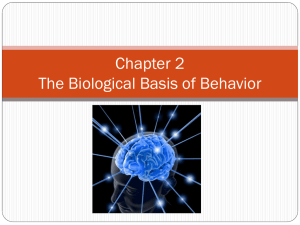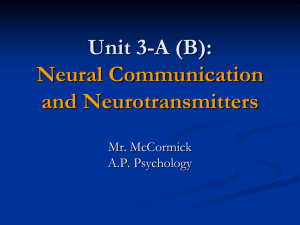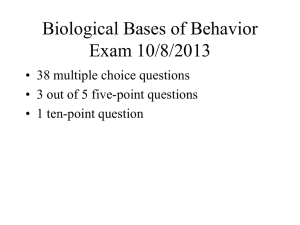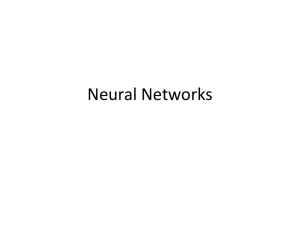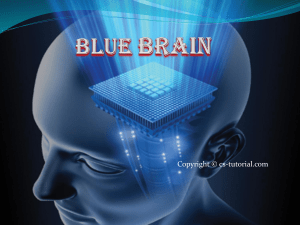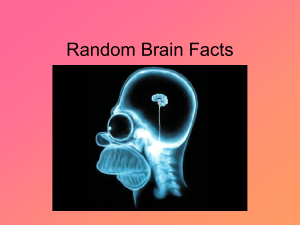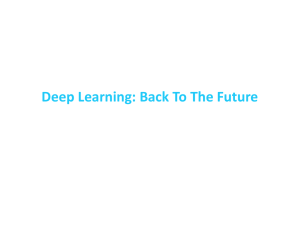Neural network
advertisement
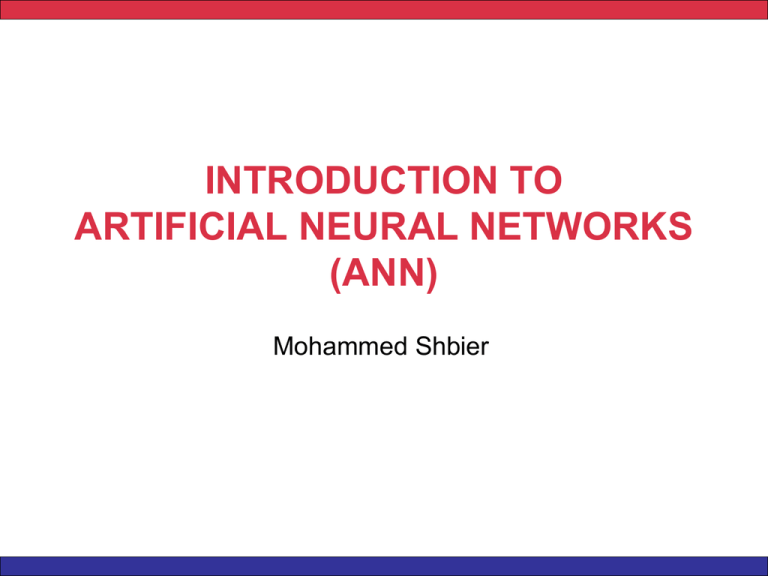
INTRODUCTION TO ARTIFICIAL NEURAL NETWORKS (ANN) Mohammed Shbier Outline Definition, why and how are neural networks being used in solving problems Human biological neuron Artificial Neuron Applications of ANN Comparison of ANN vs conventional AI methods The idea of ANNs..? NNs learn relationship between cause and effect or organize large volumes of data into orderly and informative patterns. It’s a frog frog lion bird What is that? Neural networks to the rescue… • Neural network: information processing paradigm inspired by biological nervous systems, such as our brain • Structure: large number of highly interconnected processing elements (neurons) working together • Like people, they learn from experience (by example) 4 Definition of ANN “Data processing system consisting of a large number of simple, highly interconnected processing elements (artificial neurons) in an architecture inspired by the structure of the cerebral cortex of the brain” (Tsoukalas & Uhrig, 1997). 5 Inspiration from Neurobiology Human Biological Neuron 6 Biological Neural Networks Biological neuron Biological Neural Networks A biological neuron has three types of main components; dendrites, soma (or cell body) and axon. Dendrites receives signals from other neurons. The soma, sums the incoming signals. When sufficient input is received, the cell fires; that is it transmit a signal over its axon to other cells. Artificial Neurons ANN is an information processing system that has certain performance characteristics in common with biological nets. Several key features of the processing elements of ANN are suggested by the properties of biological neurons: 1. 2. 3. 4. 5. The processing element receives many signals. Signals may be modified by a weight at the receiving synapse. The processing element sums the weighted inputs. Under appropriate circumstances (sufficient input), the neuron transmits a single output. The output from a particular neuron may go to many other neurons. Artificial Neurons • From experience: examples / training data • Strength of connection between the neurons is stored as a weightvalue for the specific connection. • Learning the solution to a problem = changing the connection weights A physical neuron 10 An artificial neuron Artificial Neurons ANNs have been developed as generalizations of mathematical models of neural biology, based on the assumptions that: 1. 2. 3. 4. Information processing occurs at many simple elements called neurons. Signals are passed between neurons over connection links. Each connection link has an associated weight, which, in typical neural net, multiplies the signal transmitted. Each neuron applies an activation function to its net input to determine its output signal. Artificial Neuron Four basic components of a human biological neuron The components of a basic artificial neuron 12 Model Of A Neuron X1 X2 X3 Wa Wb f() Y Wc Input units Connection weights (dendrite) (synapse) Summing function computation (axon) (soma) 13 • A neural net consists of a large number of simple processing elements called neurons, units, cells or nodes. • Each neuron is connected to other neurons by means of directed communication links, each with associated weight. • The weight represent information being used by the net to solve a problem. 14 • Each neuron has an internal state, called its activation or activity level, which is a function of the inputs it has received. Typically, a neuron sends its activation as a signal to several other neurons. • It is important to note that a neuron can send only one signal at a time, although that signal is broadcast to several other neurons. 15 • Neural networks are configured for a specific application, such as pattern recognition or data classification, through a learning process • In a biological system, learning involves adjustments to the synaptic connections between neurons same for artificial neural networks (ANNs) 16 Artificial Neural Network Synapse Nukleus w1 x1 y Axon w2 x2 yin = x1w1 + x2w2 Activation Function: (y-in) = 1 if y-in >= and (y-in) = 0 Dendrite -A neuron receives input, determines the strength or the weight of the input, calculates the total weighted input, and compares the total weighted with a value (threshold) -The value is in the range of 0 and 1 - If the total weighted input greater than or equal the threshold value, the neuron will produce the output, and if the total weighted input less than the threshold value, no output will be produced 17 History • • • • 1943 McCulloch-Pitts neurons 1949 Hebb’s law 1958 Perceptron (Rosenblatt) 1960 Adaline, better learning rule (Widrow, Huff) • 1969 Limitations (Minsky, Papert) • 1972 Kohonen nets, associative memory 18 • • • • 1977 Brain State in a Box (Anderson) 1982 Hopfield net, constraint satisfaction 1985 ART (Carpenter, Grossfield) 1986 Backpropagation (Rumelhart, Hinton, McClelland) • 1988 Neocognitron, character recognition (Fukushima) 19 Characterization • Architecture – a pattern of connections between neurons • Single Layer Feedforward • Multilayer Feedforward • Recurrent • Strategy / Learning Algorithm – a method of determining the connection weights • Supervised • Unsupervised • Reinforcement • Activation Function – Function to compute output signal from input signal 20 Single Layer Feedforward NN x1 w11 w12 ym w21 yn x2 w22 Input layer output layer Contoh: ADALINE, AM, Hopfield, LVQ, Perceptron, SOFM 21 Multilayer Neural Network z1 V11 x1 V1n w12 w11 w12 y1 z2 x2 y2 zn xm Vmn Input layer Output layer Hidden layer Contoh: CCN, GRNN, MADALINE, MLFF with BP, Neocognitron, RBF, RCE 22 Recurrent NN Outputs Input Hidden nodes Contoh: ART, BAM, BSB, Boltzman Machine, Cauchy Machine, Hopfield, RNN 23 Strategy / Learning Algorithm Supervised Learning • Learning is performed by presenting pattern with target • During learning, produced output is compared with the desired output – The difference between both output is used to modify learning weights according to the learning algorithm • Recognizing hand-written digits, pattern recognition and etc. • Neural Network models: perceptron, feed-forward, radial basis function, support vector machine. 24 Unsupervised Learning • Targets are not provided • Appropriate for clustering task – Find similar groups of documents in the web, content addressable memory, clustering. • Neural Network models: Kohonen, self organizing maps, Hopfield networks. 25 Reinforcement Learning • Target is provided, but the desired output is absent. • The net is only provided with guidance to determine the produced output is correct or vise versa. • Weights are modified in the units that have errors 26 Activation Functions • Identity • • • • f(x) = x Binary step f(x) = 1 if x >= f(x) = 0 otherwise Binary sigmoid f(x) = 1 / (1 + e-sx) Bipolar sigmoid f(x) = -1 + 2 / (1 + e-sx) Hyperbolic tangent f(x) = (ex – e-x) / (ex + e-x) 27 Exercise • 2 input OR • 2 input AND 1 1 1 1 1 1 1 0 0 1 0 1 0 1 0 0 1 1 0 0 0 0 0 0 28 x1 w1= 0.5 x2 y w2 = 0.3 yin = x1w1 + x2w2 Activation Function: Binary Step Function = 0.5, (y-in) = 1 if y-in >= dan (y-in) = 0 29 Where can neural network systems help… • when we can't formulate an algorithmic solution. • when we can get lots of examples of the behavior we require. ‘learning from experience’ • when we need to pick out the structure from existing data. 30 Who is interested?... • Electrical Engineers – signal processing, control theory • Computer Engineers – robotics • Computer Scientists – artificial intelligence, pattern recognition • Mathematicians – modelling tool when explicit relationships are unknown 31 Problem Domains • • • • • Storing and recalling patterns Classifying patterns Mapping inputs onto outputs Grouping similar patterns Finding solutions to constrained optimization problems 32 Coronary Disease Classification STOP 10 01 Neural Net 11 10 00 11 00 00 11 Input patterns Input layer Output layer 00 00 00 01 10 11 10 11 11 Sorted . patterns 33 Clustering 00 11 10 10 11 00 11 00 01 34 ANN Applications Medical Applications Information Searching & retrieval Chemistry Education Business & Management Applications of ANNs • Signal processing • Pattern recognition, e.g. handwritten characters or face identification. • Diagnosis or mapping symptoms to a medical case. • Speech recognition • Human Emotion Detection • Educational Loan Forecasting 36 Abdominal Pain Prediction 20 10 Ulcer Pain Cholecystitis Duodenal Non-specific Perforated 0 AppendicitisDiverticulitis 37 1 0 1 WBC Obstruction Pancreatitis Small Bowel 0 Temp Age 0 Male Intensity Duration Pain Pain adjustable 1 1 weights 37 0 0 Voice Recognition 38 Educational Loan Forecasting System 39 Advantages Of NN NON-LINEARITY It can model non-linear systems INPUT-OUTPUT MAPPING It can derive a relationship between a set of input & output responses ADAPTIVITY The ability to learn allows the network to adapt to changes in the surrounding environment EVIDENTIAL RESPONSE It can provide a confidence level to a given solution 40 Advantages Of NN CONTEXTUAL INFORMATION Knowledge is presented by the structure of the network. Every neuron in the network is potentially affected by the global activity of all other neurons in the network. Consequently, contextual information is dealt with naturally in the network. FAULT TOLERANCE Distributed nature of the NN gives it fault tolerant capabilities NEUROBIOLOGY ANALOGY Models the architecture of the brain 41 Comparison of ANN with conventional AI methods 42

